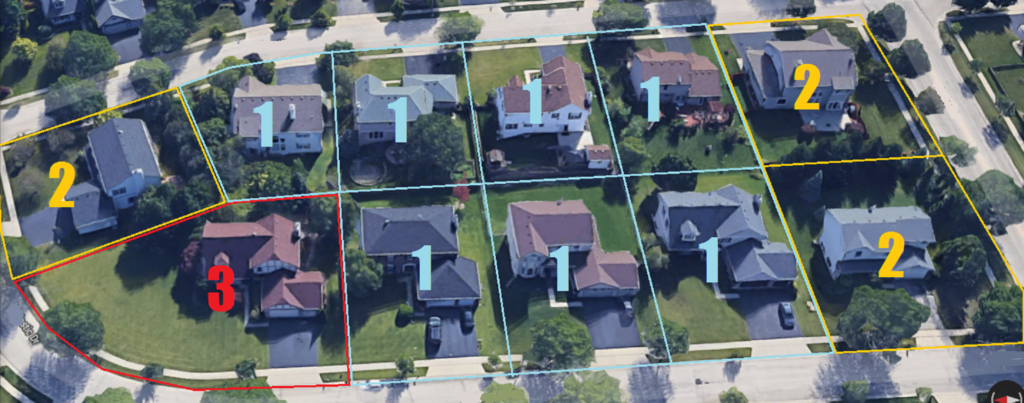Agile Estimation and Planning
Part 1 – Size
Let’s go back to the lawn example, and start with a simple explanation as to why time is a terrible way to measure size…
I asked you how big your lawn is. I want you to think of your lawn. Think of the dimensions, think of how much of it is actually available for mowing. Yes, that’s right. The grass. Not the driveway. Not the garden, nor the planting beds. Not the patio or the stoop. Got it? First of all, notice that the size of your lawn is not the size of your lot. The lot represents the dimensions of your property. But not all of that is lawn.
Are we good so far? I don’t want to lose you.
Now. Picturing your lawn, and only your lawn: How big is it? Odds are, unless you’ve played this game before, you can’t give me an exact answer. You probably could if I gave you enough time and a tape measure. You could probably get me a pretty exact measurement of the lawn part of your property. But I have two problems with that. First, it would take too long, and second, that wouldn’t be an estimate anymore, would it? It would be an actual. Traditional estimation models excel at doing this (pun intended), by giving you a really long time to lull yourself into a false sense of security in your ability to predict the future. You may have noticed this activity is often followed later by a check of how accurate your estimate was — or more to the point, how wrong you were. “We gave you months to predict the future! Why were you unable to give us a better estimate?” That’s a hell of a way to start a conversation, isn’t it? Let’s try to accentuate the positive a little, shall we?
In a moment we’ll get back to talking about the size of your lawn…by comparing it to something else! Studies have shown that while humans are pretty bad at exact estimates, they are very good at comparing things. This is a survival skill you learned as a small child – especially if you had siblings. Remember family deserts? Remember when there was one piece of cake left and both you and your pesky brother (or sister) wanted it? Remember how your mother, with the wisdom of Solomon, suggested you split the piece? The rules were simple: One of you sliced. The other one chose – which gave you all sorts of incentive to slice well.  But no matter how carefully the slicing was carried out, one piece wound up slightly bigger than the other one and I’ll wager my half of the cake that you could tell exactly which half was bigger (the one you wanted), just by looking at it. Or perhaps, they were actually close enough that there was no real distinction between them, and you both got to eat a piece of cake with satisfaction of knowing nobody got cheated. We are going to leverage this skill in Agile Estimation. The ability to look at two things, and declare whether one is bigger or smaller will prove valuable here!
But no matter how carefully the slicing was carried out, one piece wound up slightly bigger than the other one and I’ll wager my half of the cake that you could tell exactly which half was bigger (the one you wanted), just by looking at it. Or perhaps, they were actually close enough that there was no real distinction between them, and you both got to eat a piece of cake with satisfaction of knowing nobody got cheated. We are going to leverage this skill in Agile Estimation. The ability to look at two things, and declare whether one is bigger or smaller will prove valuable here!
Ready? Do you need some cake first? We don’t have time for cake. Cake is for closers. Are you a closer? Let’s see what you’ve got.
Think about your neighbor’s lawn. Let’s see if you can answer a simple relative sizing question. Is your neighbor’s lawn, bigger, smaller, or about the same size as yours? If you live in the suburbs this part will be really easy. Odds are pretty good that your neighbor not only has the same size lot as you, they probably also have a similar amount of grass in their yard.
So, what’s your answer? Is one lawn bigger than the other? Or perhaps, they’re close enough that you’re willing to call them even. We’re talking now about degree of precision. When we ask for estimates, we should not be asking for perfection. We just want to know within a margin of error.
To make this next part easier, I’m going to switch to talking about myself for a sec, partly because I’m having trouble seeing your lawn, but also because my neighborhood provides a particularly compelling example.
I can say with a fairly good degree of certainty that not only do I and my two adjacent neighbors have similar-sized lots, but the amount of open grass is pretty similar between the two — close enough at any rate. That means, in terms of relative sizing, our three lawns are the same size. How big is that? Not sure yet, let’s think a bit farther.
Now think about your neighborhood, and the finite universe of houses and lawns that surround you. Can you think of any lawns smaller than yours? Can you think of any that are bigger? If you can answer ‘yes’ to either of those questions, then the next question will be “How Much Bigger, or How Much Smaller”, and because we haven’t established a unit of measurement yet, let’s just use relative sizes.
Returning to my yard, the houses in the middle of the block all have the same lot size. I also can’t think of any houses in the area with a smaller yard; but I can think of a few yards on the corners that are bigger… almost twice as big! And then if I think about all the houses on the block, there is one house that due to the curve of the road, I’m pretty sure his lawn is closer to triple the size of mine.
I’m going to establish an arbitrary starting point now. Based on my understanding so far, my yard and my neighbors’ are all 1 point yards, the corner houses have 2-point yards, and the odd-shaped yard a 3-point yard. The chief advantage at this point, is this measurement was FAST. Not a lot of time spent agonizing over it. It was a quick 1,2, 3 and we’re ready to move on.

I now have three data points we can use to compare other work to. If someone asks me over to their house and say, “could you estimate my lawn?”, I need only look at it, and compare it against the three data points in my head. Is the new lawn bigger, smaller or about the same as one of those other lawns. And if it is bigger or smaller, how much so?
The other advantage is that this estimate is PORTABLE – meaning it can be applied to the work of more than one team. We’ll start to see why that’s important in the next section.
